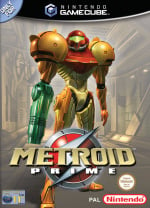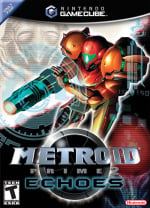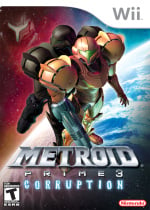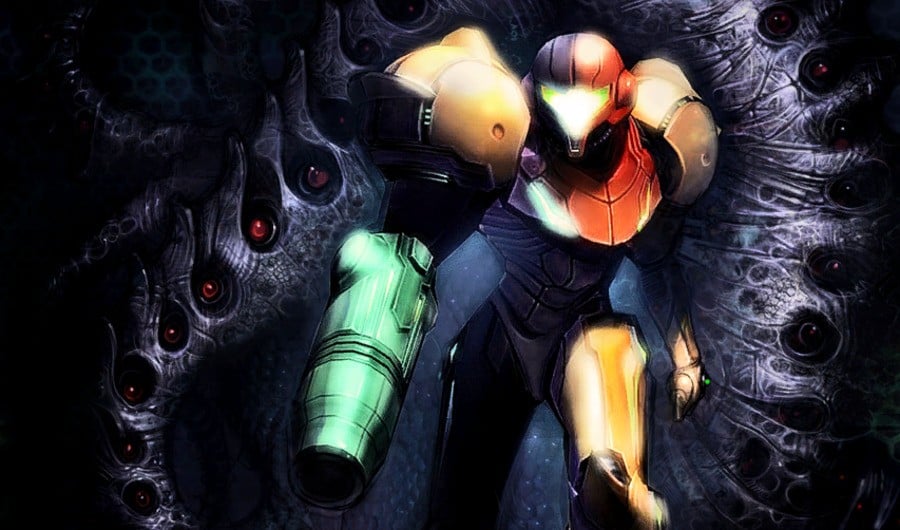
The feature was originally published back in November 2022, but we're dusting it off to celebrate the recent launch of Metroid Prime Remastered on Switch. Enjoy!
The name "Android Jones" might not be well-known in the gaming industry at large, but it’s one that every fan of the Metroid Prime series – which turns 20 years old today – should know by heart.
As Retro Studio’s Lead Concept Artist, Andrew "Android" Jones played a key role in bringing the Metroid universe into the third dimension. On top of that, when Nintendo Software Technology hit a snag in developing bounty hunters capable of taking on Samus Aran in Metroid Prime Hunters, Jones was dispatched to sort things out. In fact, Nintendo came to regard Jones so highly that, for a time, it would personally fly him out to its American headquarters to consult on art and concepts for upcoming Japanese games. Jones even co-founded his own video game concept art studio – and then, less than a decade into his tour in the games industry and despite all his astonishing achievements, he picked up and left. This is the story of Android Jones, also known as 'Retro’s Secret Weapon.'
From a very young age, it was clear that Jones was destined for art. He wasn’t into sports, reading, writing, or math. Instead, Jones was the kid we all went to school with at one point or another; the one who quietly sat at his desk in their own world as they doodled away in their notebook. Fortunately, Jones was blessed with a supportive family who saw his potential and enlisted him in after-school art lessons at an early age. Later in his teenage years, Jones joined an atelier, a very small art school consisting of just a handful of students under the tutelage of a single master. There, his prestigiously trained mentor taught him the methods and techniques of the classic art masters of yore.
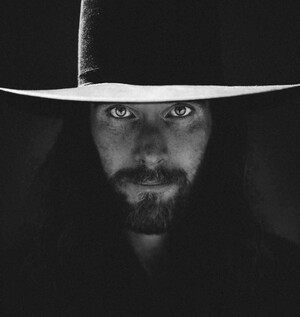
One thing Jones’ mentor especially emphasized was the need to practice drawing from real life rather than photographs. So, over his summer breaks, when he wasn’t learning at the atelier, Jones left his small hometown of Lyons, Colorado and took a trip down to the city of Boulder. His target? Pearl Street, a charming red-bricked pedestrian walkway which goes through the heart of the city’s downtown district and is packed with shops, restaurants, and tourists.
There, Jones found plenty of models to sketch and paint that he wouldn’t have to pay in the form of the homeless and runaway children who called the walkway their home and had plenty of time on their hands. While these downtrodden souls were often angered by tourists taking pictures of them, they were flattered by Jones’ requests to paint their portraits. The kids, in particular, liked to take Jones’ artwork and mail it to their parents to let them know they were okay. Soon, Pearl Street’s constant stream of tourists wanted in on the fun as well, offering to pay Jones in exchange for a portrait. This was incredibly validating to the young artist in training, proving that he could indeed make a living off his artwork.
Of course, this isn’t to say that Jones had no other hobbies outside of art. Like any self-respecting kid growing up in the ‘80s and ‘90s, he enjoyed video games and out of all the games he played, the Metroid series held a special place in his heart.
Following major brain surgery, Jones was isolated for several months while he healed up. Unable to go to school or play outside, Jones instead dove into the labyrinthian worlds of Metroid, Metroid II: Return of Samus, and Super Metroid. "It was an integral part of my healing experience just being able to dive and lose myself in a game like Metroid," Jones tell us. "It distracted me from a lot of things in the world that I didn’t want to face or deal with, and it gave me a place to really let my imagination go. …It’s very immersive, and I really did feel like I was in another world."

Reflecting his dual passions, Jones left Colorado after graduating high school in 1996 to attend the esteemed Ringling College of Art and Design (RCAD) in Sarasota, Florida, majoring in Fine Art and Computer Animation. It turned out to be an eye-opening experience in numerous ways. On one hand, he was exposed to Wacom’s line of graphic tablets and learned how to translate his years of experience in traditional art into the exploding medium of digital art. "The Wacom allowed me to take all the muscle memories and all the things I liked about physically making art and apply it digitally," he explains. In this marriage of techniques, dubbed 'digital painting,' Jones found his own personal art style and set himself apart from the competition.
Kids were getting pulled out at junior year getting bribed with Mustangs to come to work [at places like] DreamWorks
On the other, he learned everything involved with making computer-generated imagery (CGI) – from modelling, animation, coding, and so on – at a key time in the industry. The field of CGI was still red-hot thanks to Spielberg’s groundbreaking smash hit Jurassic Park. Much like college sports, talent scouts were known to visit colleges like RCAD on the hunt for the next big star to sign up. "Kids were getting pulled out at junior year getting bribed with Mustangs to come to work [at places like] DreamWorks," Jones recalls. "It was pretty exciting. There was a lot of hype around CGI and being a computer animator."
Despite this, Jones found that he didn’t care for the laboriously technical and programmatical aspects of creating CGI nearly as much as imagining and drawing out concepts for characters, creatures, or objects in the first place. He also realized that not many careers in the field permitted that freeform creativity he relished. "Computer animation is so compartmentalized [that] the person that models and animates the character is not the same person that is going to draw and design [them]," Jones says. "I [wanted] to be the guy that is drawing the monsters, spaceships, and aliens for the animators."

After some research, he discovered that the role he wanted was called a 'Concept Artist.' Jones remade his entire portfolio around concept art and went out looking for internships. Luckily, he was accepted by none other than Industrial Light & Magic, the studio behind the effects of legendary films like Star Wars, Terminator 2: Judgment Day, and the aforementioned Jurassic Park. Unfortunately, like most internships, Jones primarily spent his time scanning files, grabbing coffee, and other busywork rather than getting his hands dirty in filmmaking magic. Still, he was able to watch the masters at work firsthand and see how creative teams functioned, and it looked great on his résumé.
There’s a lot of luck that goes into being an artist, honestly... I don’t think any great artist would tell you that they didn’t have a lot of very auspicious things happen [in their life]
Upon graduating from RCAD, Jones had a number of job opportunities lying at his feet. The film industry commanded temptingly high wages, but Jones decided to join Interplay instead after hearing great things about the studio from fellow RCAD alumni and seeing the quality and talent of their art department. After moving to Southern California, Jones fell right in with Interplay’s concept art crew and went straight to work on the Heart of Winter expansion pack for Icewind Dale. Interpreting the fantastical and lore-heavy world of Dungeons & Dragons’ Forgotten Realms from an isometric perspective proved to be a challenging and educational experience that reinforced the importance of using colour effectively in his art. Additionally, Jones also got to try his hand at creating concepts for other games, including Interplay’s ill-fated Fallout 2 successor codenamed 'Van Buren,' but none of these projects saw the light of day.
Although, as much as Jones liked his job and coworkers, he didn’t enjoy living in Southern California at all. He didn’t gel with the culture and found the traffic oppressively soul-draining, especially as he spent hours commuting from Redondo Beach to Irvine along the infamous I-405 highway day in and out. Curious to see if the grass was greener elsewhere, Jones made the mistake of printing out his résumé at work. Sure enough, he was promptly called into one of the producer’s offices and let go. Now without any responsibilities and a nice slush fund from his last paycheck, Jones decided to cross a dream off of his bucket list and toured Europe. There he spent the remainder of the year exploring the old-world homes of his favourite classical artists, toured famed art museums, and painted portraits like his days on Pearl Street.

Finally, around Christmastime, Jones returned back home to the States to spend the holiday with his family when he received an email from an old RCAD classmate that remembered Jones’ stellar artwork. Apparently, a new development team by the name of Retro Studios based out of Austin, Texas, was working on a brand-new Metroid game. As you might expect, Jones was sold instantly. He got his portfolio ready, including a couple of pieces featuring Samus, and sent it off. Soon enough, he was flown out to Texas for an interview and ramped onto the project. "There’s a lot of luck that goes into being an artist, honestly," Jones admits. "I don’t think any great artist would tell you that they didn’t have a lot of very auspicious things happen [in their life]."
She was a muse of mine. I did a lot of figure drawings of her in a lot of poses and positions, and then I’d draw [Samus’ Varia] suit on top of that
At Retro Studios, Jones quickly became Metroid Prime’s Lead Concept Artist, and his first and arguably most important job was bringing Samus to life in 3D. For this, he turned to a figure model he met during his days in Colorado. Whenever wasn’t she modelling, she was dancing as a ballerina and the delicate yet demanding artform granted her a similarly lithe yet muscular physique. "She was a muse of mine," Jones states. "I did a lot of figure drawings of her in a lot of poses and positions, and then I’d draw [Samus’ Varia] suit on top of that. Those became the anatomical base that I would then build the architecture of [Samus] and her armour around."
Afterwards, Jones switched his focus to reimagining classic Metroid foes like Ridley as well as creating new creatures to populate the world of Tallon IV. Updating old designs for a new game might seem like the easier job of the two, but that wasn’t the case with Metroid Prime. "It was a lot of understanding what were the parameters that I could work between and what does it mean to reinterpret an 8 or 16-bit design into a three-dimensional world," Jones clarifies. "What were the components of the character that made it iconic? Where could we push that into something that’s more contemporary and what were the elements of it that needed to be faithful to the original design? That was always a conversation, a back-and-forth process between us and [Nintendo of] Japan, and just finding the right balance between honouring what had come before and whatever new contributions [to the series] we could make."

Bringing the beloved Metroid franchise to a new generation with a young studio filled to the brim with talent and passion alongside none other than Nintendo themselves (with frequent visits from gaming legends like Shigeru Miyamoto) all made working at Retro Studios feel like a dream come true at the time. "I don’t think I’ve ever been as passionate about a work project," says Jones today. "I really wanted to make Metroid [Prime] my [concept art] masterpiece of a game."
I don’t think I’ve ever been as passionate about a work project... I really wanted to make Metroid [Prime] my [concept art] masterpiece of a game
However, it wasn’t without its challenges. Namely, the working conditions were brutal. There was always something more for Jones to draw from bosses all the way down to the images on Samus’ scan logs. More often than not, Jones found himself working at the office so late into the night that he’d end up sleeping there before waking up and getting back to work the following morning without a day off in sight.
This was further exasperated by Nintendo’s obsessive attention to detail and demanding perfectionism. For example, whenever Jones came up with a concept for a character or creature in the game, it would be sent over to Japan. Nintendo’s internal team would then look over it and send back feedback, sometimes as soon as the next morning. Jones would take their feedback and redraw the concept, trying to find a compromise between his vision and theirs, before sending it over to Japan once more, where the process started all over again.

Sometimes this didn’t take too long, especially for the wholly new creations, like Flaaghra (the plant/insect hybrid boss of the Chozo Ruins). However, Nintendo went through the designs of some of the established Metroid characters or creatures with a fine-toothed comb and a near-fanatical level of stringency. "Gosh, the amount of iterations that we went through just coming up with the Varia Suit was unbelievable," winces Jones. "I mean, every parting line of Samus’ suit was under a microscope." Interestingly, however, he was given plenty of flexibility to redesign the Space Pirates and Chozo – the latter of which he happily reimagined to be more mystical and shamanistic compared to their (admittedly sparse) appearances in earlier games, a theme that has remained with the Chozo ever since.
Gosh, the amount of iterations that we went through just coming up with the Varia Suit was unbelievable
In spite of the blood, sweat, and tears, Jones still fondly looks back at his time spent on Metroid Prime. The glowing reception the game received at its launch and to this day makes it all the sweeter. After all, Metroid Prime is a success story of a plucky young studio taking an enormous project of a beloved franchise and knocking it out of the park on their first shot. It’s the kind of underdog tale more often seen in schmaltzy Hallmark flicks than in reality, but reality did rear its ugly in the end.
After Metroid Prime’s release, everyone involved received a royalty bonus in light of the game’s astounding success. At the time, Jones happily accepted the extra bit of cash without thinking too hard about it. That was until someone within the company leaked a document which broke down how the royalties were distributed, and it wasn’t remotely close to even.

"When the team found out how [large] the pot was of royalties and how management decided to divvy up those royalties amongst the team [compared] to themselves, it was anarchy," Jones remembers. "The difference between what the producers paid themselves versus what they allotted to the art directors was so insultingly asymmetrical that I don’t think that the core team ever recovered from that, honestly. You could never look the producers in the face again and feel any kind of dignity or respect for how asymmetrical they saw their [own] value versus how they valued the people on the team."
When the team found out how [large] the pot was of royalties and how management decided to divvy up those royalties amongst the team [compared] to themselves, it was anarchy
In fact, Jones feels this accounts for the stark visual difference between the primary-colour-filled Metroid Prime and its much darker, grittier, and more oppressive follow-up, Metroid Prime 2: Echoes. "I think a lot of that is reflective of what was going on with me and my world and also the culture of Retro and what was going on [internally]."
On the bright side, however, Retro Studios earned Nintendo’s trust wholeheartedly and allowed the team much more creative freedom while designing the sequel. It wasn’t entirely one-sided either; by now, Jones knew what Nintendo of Japan appreciated, what the hardline boundaries were, and how to play within them without feeling constrained. Still, Jones and the rest of the development team happily came up with more original creations for Metroid Prime 2 that wouldn’t need to be scrutinized as heavily as reprisals from the earlier games. This made Metroid Prime 2 a much more liberating experience compared to the first game.

For instance, whereas recreating the Varia Suit became a frustrating ordeal of endless reiterations, Jones was free to experiment with different shapes and silhouettes for the new suits of Metroid Prime 2. Jones was particularly inspired by the duality of the bright hope of the Luminoth versus the malicious darkness of the Ing while creating the sinuous Light Suit and the mechanical Dark Suit – two of the more unique suits in Samus’ armoury. "It was really refreshing having a wide-open blue sky [without] a precursor I had to work from," Jones says. "The experience, especially after the rigidity of the original suits, was really great – to just come up with wild ideas and see what people liked."
A lot of it was coming up with all of Samus’ pros and cons. What can she do and what would be another skill that could rival that, be as interesting, or be a foil to that?
Afterwards, Jones was deployed to Nintendo of America’s headquarters in Redmond, Washington, to help Nintendo Software Technologies (NST) design the eponymous hunters of Metroid Prime Hunters. While NST had the general ideas down for the hunters, it was experiencing difficulties wrapping them into interesting visual designs that fit the Metroid series’ art style and met Nintendo’s expectations.
However, while Jones often spent a week or more designing each character in Metroid Prime 1 & 2, he only had a single week at NST to design all six of the hunters. His time there turned into a binge of creativity where Jones distinctly defined each of the hunters while working within the tighter limitations of the Nintendo DS’ hardware. He also liberally tossed out design ideas left and right to further improve what NST had come up with. "There was some flexibility where there were some things that were just ideas, and the mechanics weren’t worked out yet," he recalls. "So I would come up with some ideas as I was designing [them]. A lot of it was coming up with all of Samus’ pros and cons. What can she do and what would be another skill that could rival that, be as interesting, or be a foil to that? You can’t make anybody too powerful or too weak; you have to make them all balanced and compelling characters."
Nintendo was so impressed with Jones’ artistic eye and swiftness that it decided to continue periodically flying him over to its American headquarters to go over art and concepts for other games. Jones was often presented with artwork from Nintendo’s Japanese branches and asked to reiterate or redesign them with an eye towards what western audiences appreciated. It’s tough to tell how much Jones’ art influenced the games he consulted (some of which were never released), but the level of trust Nintendo had in him was stunning. "I was the guy!" Jones laughs. "It was so cool."
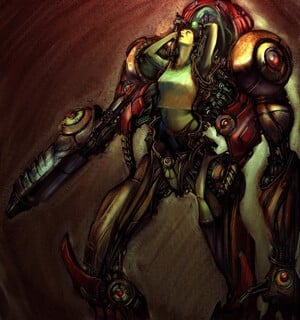
Meanwhile, outside of his work with Retro and Nintendo, Jones was busily cultivating a (now defunct) online community called ConceptArt.org. It was a website dedicated to sharing professional-grade art, similar to today’s ArtStation, but, as its name suggests, laser-focused on concept art. As the community grew, Jones and his friends on the website used it as a platform to begin hosting art workshops. The workshops were so successful that it got the group thinking. "You know what, instead of us being individual concept artists at different studios, what if we pooled all of our resources together and kinda created a concept art Voltron," recounts Jones. "We’d decided [it’d] be better to be our own bosses and have our own company." The company born out of these plans was named Massive Black and serves as a concept art studio where game developers or publishers can hire out the team to crack out concepts and designs for their games to this day.
Jones hoped to work at both Retro and Massive Black at the same time, especially since the latter planned to lay down its roots in Austin as well. However, the group switched gears and decided to base itself out of San Francisco, California, instead. This left Jones with a tough decision as, despite the earlier drama, he still really enjoyed his life at both Retro and Austin, but it was time to move on.

Nevertheless, he didn’t want to abandon Retro at such a critical time as its ramped into the development of Metroid Prime 3: Corruption, so Jones cut Retro a deal. He’d officially leave Retro and join Massive Black in San Francisco, but he’d take on Metroid Prime 3 remotely as his first contract job at his new company. While Jones’ role in the concept art department of the game took more of a backseat compared to the first two Metroid Prime games, the partnership still worked out for everyone. In fact, Jones found it to be even more invigorating than his time within Retro Studios, as being surrounded by some of the best talent in the video game concept art industry at Massive Black fueled him to work even harder to prove himself among his new crew.
"I feel like the strength of the designs I did for [Metroid Prime] 3 [showcases] more form, more 3D, and more detail," Jones explains. However, as much as he treasures his artwork on the game, Metroid Prime 3 itself isn’t as close to his heart as the prior two entries in the series. In fact, Jones admits that he’s never even played it. Part of this is due to the fact that working remotely meant that Jones wasn’t as intimately involved with the game nor the team as he was beforehand, but it was also indicative of changes in Jones’ life.
While working with Massive Black on games like Flagship Studios’ Hellgate: London, Jones began to realize that, despite seemingly being on top of the world in the industry, he was falling out of love with it. As he worked on more and more games, Jones had less and less time to actually play them. He still liked creating the art, but the games themselves began to hardly matter anymore. The grind quickly lost its lustre as well. "You’re only really as good as 'What have you done for me lately?' in concept art," Jones explains. "The stress of constantly trying to prove yourself and the competition – I just got tired of that." Moreover, while Jones made many lifelong friendships over his tenure, the drinking, egos, drama, and 'dudebro' culture of the industry were finally starting to wear on him, too.
Around the same time, Jones was introduced to the eclectic Burning Man festival, the visionary art scene, and psychedelia which he gradually felt more at home with. Instead of cramming for hours on end in dark studios, these artists were freely making art in the wilderness at their own pace. The community was a fellowship that celebrated another’s achievements instead of a constant dog-eat-dog competition. Finally, and perhaps most important of all, the artists created art that they wanted to create, making it wonderfully diverse, especially when compared to the endless deluge of monsters, weapons, and vehicles that video game publishers demanded. Once one of Jones’ original artworks was featured on a volume of Spectrum, an artbook series highlighting the best works of contemporary fantastical art, he saw his window to make a change. Jones quit Massive Black and the entire games industry at large, leaping headfirst into a career as a fine artist.
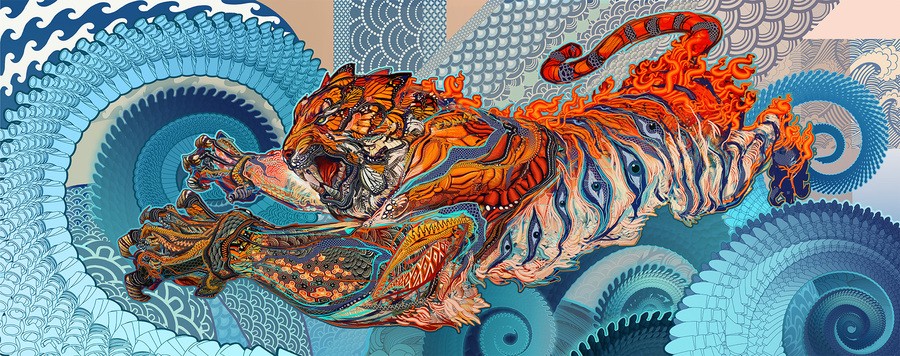
Since then, Android Jones has enjoyed a fulfilling career creating album covers, visuals for events, painting murals, and more, on top of selling his own art prints and merchandise. If you’re interested in checking out his work for yourself, head over to his website or Instagram page. Additionally, gamers with access to a VR headset might be interested in giving Microdose VR a try, which Jones played a key role in creating. To be clear, though, Jones stresses that Microdose VR is more of an experience – or, as he and his team like to call it, a "flow state stimulant" rather than a traditional game. While the program is a shoo-in for raves and music festivals, Jones hopes that the project can also be used for meditative and therapeutic purposes to help people overcome difficult times as well.
With all that being said, the question remains, will we ever see Jones contribute his talents to a video game again? For his part, Jones is open to it… as long as the right game, like another entry in the Metroid series, comes along that is. Unfortunately, he isn’t working on Metroid Prime 4, so only time will tell if the artist will cross paths with the series (or any other video game series, new or old, for that matter) down the road.

